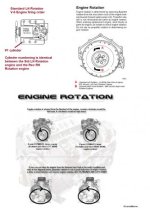FstaRockr Burns
Regular Contributor
Just installed the rebuilt starboard after it was seized.. was curious - manual states a firing order of 1-2-3-4-5-6 for the 229 reverse rotation.. the whole motor turns the opposite direction ..
i have read there are variations on the cams / firing order. And i was not aware of this until after putting it back in.. SO q is - before i pull all plugs out to verify manually (which is what i should have done on the bench! & real hard cos you cant really turn the motor by hand without removing pulleys and installing a damper mounted device -
were there varying firing orders for the 229's counter rotation? this is an 84 model -
tx
i have read there are variations on the cams / firing order. And i was not aware of this until after putting it back in.. SO q is - before i pull all plugs out to verify manually (which is what i should have done on the bench! & real hard cos you cant really turn the motor by hand without removing pulleys and installing a damper mounted device -
were there varying firing orders for the 229's counter rotation? this is an 84 model -
tx


